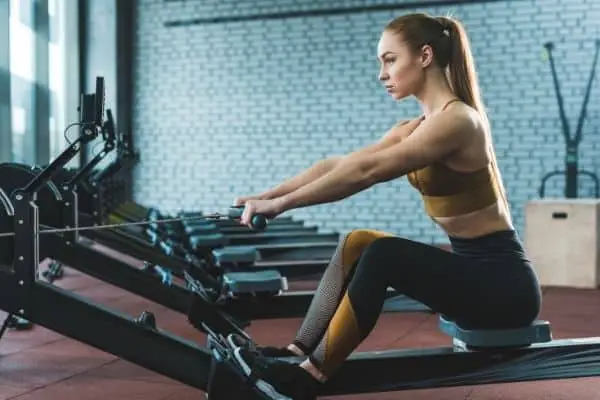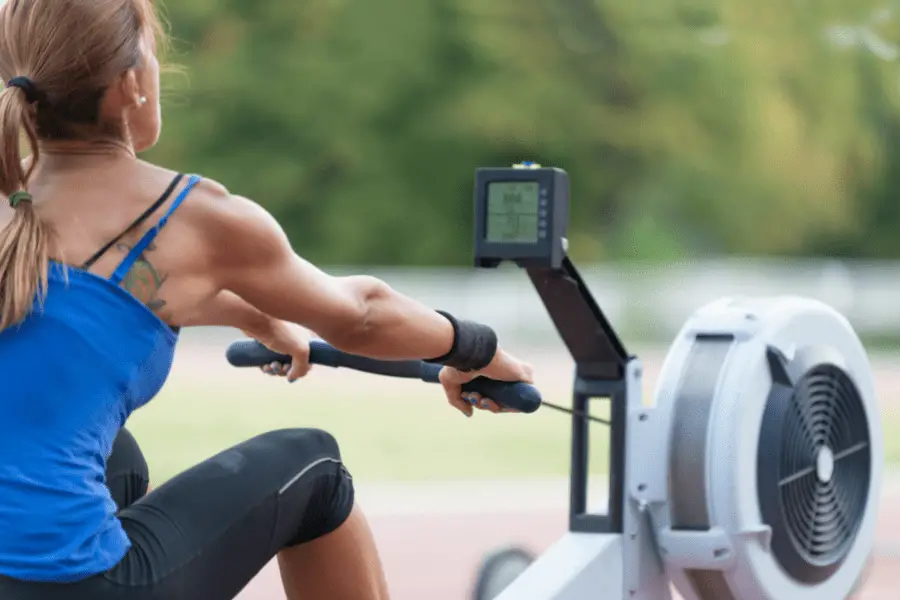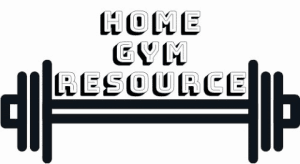An indoor rowing machine is an efficient and fun way to get into shape without leaving your house. But how big are they and how much space do you need to use it properly? Here’s what you need to know.
The average indoor rower measures 83.1” L x 21.9” W (211 x 55.6cm). To have enough clearance for use a rower needs 1’/30.5cm behind and 1’ of free space on both sides. The average rower needs 4’x8′ of free floor space. Concept2 rowers are longer than average and need 4’x9′ of floor space to use.
To find and compare the dimensions of a lot of different rowing machines that are currently available, scroll down. You can also find how much space you need exactly and why.
Contents
How Big Is An Indoor Rowing Machine?
Before we get into how much space you actually need for a rower, we have to figure out how big these machines actually are. Here is a list of many popular indoor rowing machines that are currently on the market. You can find the exact dimensions of all these machines in inches below.
| Brand | Model | Folding | Length (in) | Width (in) | Height (in) |
|---|---|---|---|---|---|
| LifeSpan | RW7000 | Yes | 90 | 18.5 | 23 |
| LifeSpan | RW1000 | No | 98.4 | 24.7 | 48 |
| Life Fitness | Row GX | Yes | 76.8 | 31.5 | 39.4 |
| Life Fitness | Row HX | No, can be stored upright | 83.85 | 20.47 | 22.04 |
| BodyCraft | VR200 | Yes | 79 | 17.75 | 36.25 |
| BodyCraft | VR400 | Yes | 98.5 | 21.25 | 40.25 |
| BodyCraft | VR500 | Yes | 98.5 | 20 | 38.5 |
| Body-Solid | R300 | No | 95 | 24 | 40 |
| Marcy | Turbine | Yes | 85 | 20 | 34.5 |
| Marcy | NS-40503RW | Yes | 74 | 20 | 33 |
| Marcy | NS-6002RE | Yes | 74.5 | 20 | 32 |
| Marcy | NS-6070RW | No, can be stored upright | 79 | 22 | 42.25 |
| Marcy | NS-6023RW | No, can be stored upright | 77 | 19 | 36 |
| Concept2 | Model D | Yes | 96 | 24 | 44.5 |
| Concept2 | Model E | Yes | 96 | 24 | 20 |
| Sunny Health | SF-RW5515 | Yes | 78 | 19 | 23.2 |
| Sunny Health | SF-RW5622 | Yes | 72 | 21 | 18.8 |
| Sunny Health | SF-RW5801 | Yes | 77 | 23 | 22.5 |
| Fitness Reality | 1000 | Yes | 88.5 | 21.5 | 21.5 |
| Fitness Reality | Dual Transmission | Yes | 70 | 23 | 26 |
| Fitness Reality | 3000WR | No, can be stored upright | 77.3 | 20 | 34 |
| Fitness Reality | 4000MR | Yes | 72 | 25 | 51.5 |
| ProForm | Pro R10 | Yes | 86.5 | 22 | 45.5 |
| ProForm | 750R | Yes | 86.5 | 22 | 45.5 |
| NordicTrack | RW 600 | Yes | 87.02 | 22 | 47.24 |
| NordicTrack | RW 700 | Yes | 87 | 22 | 47 |
| NordicTrack | RW 900 | Yes | 86.5 | 22 | 50.4 |
| Schwinn | Crewmaster | Yes | ? | ? | ? |
| Stamina | ATS 1403 | Yes | 77 | 18 | 22 |
| Stamina | 1110 | No, can be stored upright | 60 | 22 | 27.25 |
| Stamina | Elite Wave | Yes | 85 | 20 | 33 |
| Horizon | Oxford 3 | No, can be stored upright | 80.7 | 24.5 | 43 |
| Horizon | Oxford 6 | No, can be stored upright | 82.7 | 24.5 | 43 |
| Xterra | ERG200 | Yes | 71.9 | 20.7 | 31.5 |
| Xterra | ERG220 | Yes | 80.3 | 19 | 29 |
| Xterra | ERG400 | Yes | 72 | 18.9 | 33.1 |
| Xterra | ERG500 | Yes | 72 | 19 | 33 |
| Xterra | ERG700 | Yes | 97 | 18 | 38 |
| Xterra | ERG600W | No, can be stored upright | 80.7 | 22 | 33 |
| WaterRower | Club | No, can be stored upright | 83 | 24 | 21 |
| WaterRower | A1 | No, can be stored upright | 84.65 | 22.05 | 20.87 |
| WaterRower | Classic | No, can be stored upright | 82.25 | 22.25 | 20 |
| WaterRower | M1 | No, can be stored upright | 84 | 30 | 22 |
| WaterRower | S1 | No, can be stored upright | 82.25 | 22.25 | 20 |
| Octane | Ro | No, can be stored upright | 94 | 24 | 47 |
| Hydrow | No, can be stored upright | 86 | 25 | 47 | |
| Ergatta | No, can be stored upright | 86 | 23 | 40 | |
| Assault Fitness | Elite | No | 92.5 | 20.1 | 48.6 |
| Average | 83.1 | 21.9 | 34.4 | ||
| Min | 60 | 17.75 | 18.8 | ||
| Max | 98.5 | 31.5 | 51.5 |
There is quite a bit of variability in the size of rowing machines although not as much as some other types of equipment like elliptical trainers or treadmills.
On average, an indoor rowing machine measures 83.1” (L) x 21.9” (W) x 34.4” (H).
The height is actually the measurement that changes the most between machines but at the same time it’s the least important measurement. If a machine is significantly higher than average, it’s usually because it has a big console or screen on it that sticks out. The seat height is almost always lower than the maximum height of the machine.
Indoor rowing machines are quite long with lengths ranging from 60” to 98.5”. This is an important measurement for two reasons;
- A very long rower can be difficult to fit if you’re working with a small space.
- A very short rower could mean it’s too short for you and you can’t finish the movement naturally but get cut short because the rail ends.
There are some design changes that can change how long of an inseam the rower can handle so you can’t just translate the length of the machine into how tall of a person can use it although they are related. The average rowing machine can handle people with an inseam up to about 34″-36”. The relatively long Concept2 rowers can handle people with inseams up to 38” and they even have a rail extension available.
Widths of indoor rowing machines range from 17.75” to 31.5” although the vast majority is close to the average of 21.9”. Liquid rowers are usually the widest because of the water reservoir. Magnetic and air rowers can be built much narrower.
Suggested: The 4 types of indoor rowing machines
Rowing machines are really suitable forHigh Intensity Interval Training (HIIT). This ss a great way to burn more calories in a short period of time. A good interval timer is going to make HIIT workouts much more enjoyable. Check out the GymNext Flex timer. It’s super easy to set up and control contrary to most other interval timers making the set up for any workout a breeze.
How much space do you need to use an indoor rower?

Above you can find the exact dimension of many popular rowing machines. That doesn’t tell the full story though. To actually be able to use it, you often need more space around the machine so you don’t bump into anything when using it.
The extra space you need is mainly because your body sticks out over the actual dimensions of the rower. You pull your body back and often your head sticks out behind the slide rail. At the same time your arms will flare out a little making your profile much wider.
To use an indoor rower, you need a floor space that is at least 4’/122 cm wide and 1 foot/30.5 cm longer than the total length of the rower. That means for most rowers you need a minimum of 4’x 8’ or 4’ x 9’ of free floor space.
The average indoor rower is just shy of 7’/213 cm long with the most popular models being 8’/244 cm long. You want at least 1’ of free space behind the rower to be free of anything so you don’t bump your head. That means you need a space 8’ long for an average rower and 9’ long for the popular Concept2 rowers. The front of a rower can be places close to the wall as long as it doesn’t touch during use.
Suggested: How to prevent an indoor rowing machine from moving around
The average width of an indoor rower is a little bit less than 2’/61 cm. You want at least a foot on each side so your arms have some space to flare out.
People that are exceptionally tall might want to add another half a feet to the length and width of floor space you need. If you’re taller and have longer limbs, you’re going to stick out further.
Having more space than that available is always good because it will make things more comfortable. To get some fresh air, having more free space on at least one side is very welcome.
Rowers are one of the best cardio machines to use under low ceilings since they have a low seat height and you don’t stand up during use. You could use a rower under 5’ tall ceilings if you wanted to, just be careful standing up after your workout.
Suggested: The best cardio machines for use under low ceilings

Storage dimensions
Indoor rowing machines might seem like they are quite large and need a lot of space to be used. However, the good news is that this is usually only the case to actually use them.
Many models have the option to fold up the slide rail, which is the longest part, and significantly reduce the footprint of the machine. Of course that’s only good when you don’t want to use it but it’s still pretty useful.
Suggested: Best indoor rowing machine under $400
It’s much easier to free up the necessary space for 30-60 minutes a day while using it and then folding it up after your workout so it’s not in the way.
Not every model can fold and not every model that can fold makes this very easy to do. Some require a few screws to be removed before you can take it apart while others have a super simple mechanism that allows you to do it in a few seconds. So if you’re planning to fold and unfold your rower regularly, pay close attention to how easy it is.
Another way manufacturers solve this problem is by making the whole machine storable upright. You simply pick up the back of the machine and lift it until it’s upright. This way you can put it against a wall which is much more space efficient. Rowing machines are usually pretty light and can be lifted by anyone. Especially since you only lift the lightest part.
Suggested: Is 30 minutes on a rowing machine enough to see results?
Favorite Cardio Accessories
Check out these accessories that improve a home cardio workout:
- Equipment mat: All cardio equipment should be put on an equipment mat. The Rubber-Cal mat (Amazon) is an affordable yet very high-quality choice.
- Interval timer: To time your intervals and workouts, there is no better choice than the GymNext Flex. It’s super easy to use and set up with a phone app.
- Tablet holder: Cardio can be boring. With this tablet holder (Amazon) you can follow along with on-demand workouts or just watch a movie on any cardio machine.
- Heart rate monitor: Monitoring your heart rate is very important while doing cardio. The Polar H10 (Amazon) connects to almost anything you can imagine and is very accurate.
To find which cardio machines I recommend for home gyms, click here.

